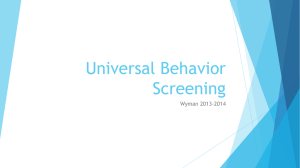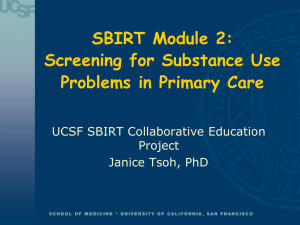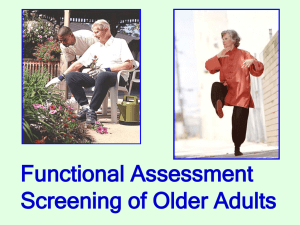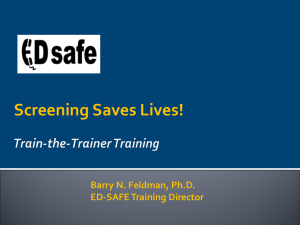Train-the-Trainer Training
advertisement
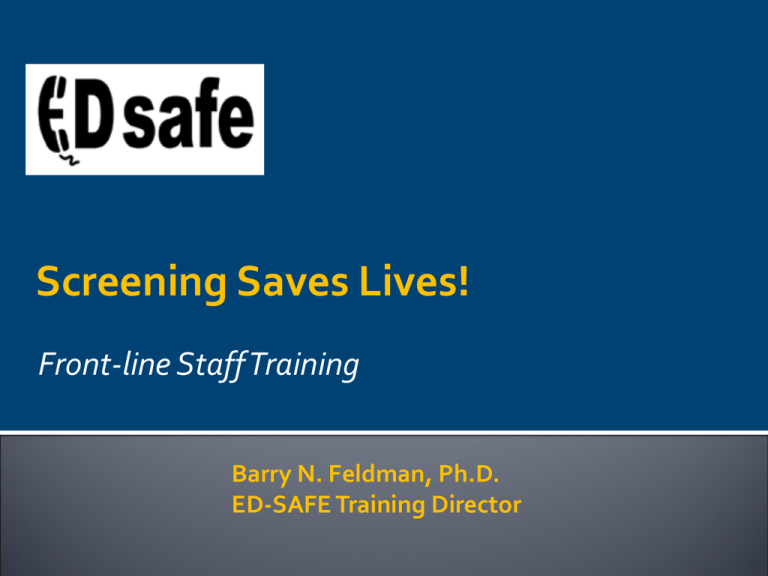
Screening Saves Lives!
Front-line Staff Training
Barry N. Feldman, Ph.D.
ED-SAFE Training Director
Tom is a 51 y.o. with multiple minor trauma secondary to
MVA. Alert, oriented, conversant. Treated for trauma, then
discharged from ED. One week later, found dead by his
neighbor. He had hung himself in his garage. The MVA
was an unrecognized suicide attempt.
Could Tom’s suicide have been prevented?
Screening Saves Lives
2
Often lack formal mental health training
Often do not have confidence in psychological assessment
and intervention skills
May often be uncomfortable treating this patient population
Therefore, evaluations of suicidality may be particularly
stressful or avoided
Screening Saves Lives
Conduct a risk assessment that identifies specific patient
characteristics and environmental features that may increase
or decrease the risk for suicide.
Address the patient’s immediate safety needs and most
appropriate setting for treatment.
When a patient at risk for suicide leaves the care of the
hospital, provide suicide prevention information (such as a
crisis hotline) to the patient and his or her family.
http://www.jointcommission.org/standards_information/jcfaqdetails.aspx?
StandardsFAQId=166&StandardsFAQChapterId=77
Screening Saves Lives
4
Nurses’ perspective:
“...having (a) screening tool was much preferred to the previous
method of judging by intuition when and how to ask about
suicidal behavior.”
With proper structured tools to guide them, non-mental
health clinicians can increase their confidence and
lower barriers to asking about suicidality.
Screening Saves Lives
Vital signs (e.g., blood pressure)
Routine assessment with all medical encounters
Not commonly done at all medical visits until the 1970s
Identification of possible hypertensive emergencies and other vital
sign abnormalities that could affect patient outcome (i.e.,
hypotensive)
Potentially devastating consequences
Screening Saves Lives
6
3-item screener
Question 1: Depressed mood - PHQ-2
Question 2: Thoughts of killing yourself - C-SSRS
Question 3: Lifetime suicide attempt - C-SSRS
▪ If yes, Question 4: How recent?
Positive screen
Question 2=Yes
(or)
Question 3=Yes and Question 4=attempt within last 6
months
Screening Saves Lives
7
Over the past 2 weeks, have you had thoughts of killing yourself?
Criteria for positive
response
Patient endorses
active ideation
Ambiguous Answer
Score Y or N?
“Well, I haven’t really
thought of killing
myself, but I have
wished that I just
wouldn’t wake up”
Score: NO
Patient endorses
passive rather than
active ideation
Have you ever attempted to kill yourself?
Criteria for positive
response
Ambiguous Answer
Score Y or N?
Patient endorses
attempt to kill self
“Well, I cut myself but I
wasn’t really trying to
kill myself”
Score: NO
Patient endorses nonsuicidal self-injury
Screening Saves Lives
8
Avoid acting “like a robot” while conducting screening
Important to convey you are interested in what patient has
to say
Be empathizing, accepting, and understanding
Be non-judgmental re: patient’s history, situation, beliefs,
sexuality, actions
Show you care with compassion, tone, and rate of speech
Be fully-attentive
Use appropriate active listening techniques
Screening Saves Lives
9
Patient Safety Screener Not to be used with
Children/Teens
Patient Safety Screener was not specifically designed or
validated with children/teens
Children/Teens can be screened in a manner decided by the
site
Screening Saves Lives
10
Patient is intoxicated
If the patient is currently intoxicated, but a clinical interview is
initiated, the Patient Safety Screener should be administered
per standard protocol
Once the individual is clinically sober, the Patient Safety
Screener should be re-administered
If the patient is intoxicated but a clinical interview is not
initiated until the individual is clinically sober, then the Patient
Safety Screener should be administered at that point
Screening Saves Lives
11
Patient is claiming to be suicidal but the clinical staff suspect it is
simply to get into inpatient care
Patient is a prisoner or under state custody
Patient is a high utilizer of the ED
Patient is an active duty military service member or a veteran
. . . .Answer is the same: screen them in the same manner as
you’d screen those who do not present this way.
Screening Saves Lives
12
{insert description of your site’s protocols}
Screening Saves Lives
13
